Fundulopanchax filamentosus Meinken 1933

Aquarium strain circulating in the BKA early 1980's.
| Meaning of Name |
With filaments. |
|||||||||||||
| First Description |
Meinken H. 1933 (Fundulopanchax filamentosus). Über einige in letzter Zeit eingeführte Fische 5. Fundulopanchax filamentosus. Blätter für Aquarien und Terrarienkunde 44 (15): p 249-251, figure. |
|||||||||||||
| Size |
5.5 cm |
|||||||||||||
| Meristics |
|
|||||||||||||
| Karyotype |
n = 15-18, A = 20-24 (Scheel 1972) |
|||||||||||||
| Sub-Genus |
Paludopanchax |
|||||||||||||
| Group |
arnoldi |
|||||||||||||
| Synonyms |
|
|||||||||||||
Populations
|
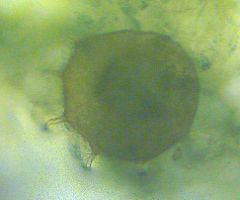 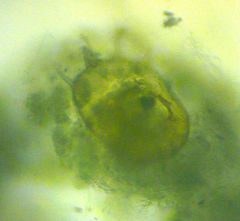 Abule Oba River - Commercial
collection I brought in November 2023. Ibefon - Possible corruption & could be Ibefun located south west of Ijebu Ode. Majidun - NG MM 14 - A shipment into the USA in 2014. This was coded NG MM 14 which stands for Nigeria -Macowiak & Mazzola 2014. Situated betwen Lagos (Ikeja) & Ikorodu. A piece of open country with a small river passing under a culvert.
Southern Togo -
|
|||||||||||||
| Type Locality |
Meinken gives the location of the type locality as 'the mouth of the River Niger' but the exact location is unknown.
Meinken's 1933 watercolour painting of fish from the type locality. Note the flared pattern to the upper & mid sections of the caudal fin. This form was maintained in aquaria through WWII by Walter Berthold who lost them all through a heater problem. Roloff took a photo of this form in the '30's. |
|||||||||||||
| Distribution |
The coastal plain of Togo in the west. Easterly to the south west Nigerian coastal plain. |
|||||||||||||
| Habitat |
Generally found in temporary waters caused by receeding flood waters, raffia swamps & swampy parts of shallow brooks. |
|||||||||||||
| Distinguishing Characteristics |
This species is perhaps most often confused with its close relative Fp.arnoldi. The difference is clearly seen however in the caudal peduncle which is much thinner in arnoldi. Females may be distinguished from its close
neighbour Fp.arnoldi by the shape
of the caudal fin which is more rounded in filamentosus.
Also, the eyes are slightly larger in arnoldi. Eggs seen under a microscope also show differences. Eggs of filamentosum are larger than arnoldi & have few 'hairs' whereas arnoldi are smaller & have a noticeable amount of 'hairs'. |
|||||||||||||
| Colour/Pattern Variability | Fairly high. Their is a great variance for instance between populations from Lomé & Ikeja. | |||||||||||||
| History |
Although this species was described by Meinken in 1933 they were referred to by Kruger in 1913 as 'The steel blue Fundulus'. These were thought to have originated from the mouth of the River Congo, although this information was considered unreliable. Later in 1913 the aquarium society 'Nymphae' corrected this description & stated that this fish had been collected by one of their members at Lomé. In 1915 Dieterich had a similar strain but the anal fin differed from Kruger's fish in having a broken red sub-marginal band which formed 3 blotches. On the basis of the caudal fin resembling more arnoldi than filamentosum he attached the name 'arnoldi var. blue' (or blue variety of arnoldi). In 1917 Sachs bought an identical pair & stated that this fish was also known by the name 'Fundulus aus Togo' (or Fundulus from Togo) but was rare in Germany at the time. In 1930 Meinken identified this fish as Aphyosemion gardneri. The article I have contains a photo of the species marked up as gardneri (which it obviously isn't). The name of the publication is 'The Aquarium' (an Innes publication now TFH)dated December 1952 page 333. The type specimen of filamentosum appeared in Germany in 1931/32. Meinken produced a watercolour painting of these fish.
Fp.filamentosus
imported into Germany before WWII. This photo was taken by Roloff
in 1938 using natural daylight. Roloff attributed these long fins
to maintaing them in tanks without gravel. Note anal bar in this photo
which is absent in Meinken's painting. Willi Harvey kept these fish in 1936 & photograped them. They were kept alive in Germany until the end of the war by friends of Willi's. Roloff mentioned that Karl Berthold was the only one to maintain them through the war but lost all his stock on Christmas day 1947. Some reports have mentioned this was due to a heating problem which is true to a point. Roloff stated that he was carrying a tank containg 80 young which slipped out of his hands onto another glass tank containing the brood stock. Both tanks broke up sending the fish over a heating unit which killed all the fish immediately. This effectively wiped out all of this form. (AKA Journal March 1975). Roloff's photo above would probably fit these fish. In October 1950 Willi returned to Germany to obtain fish. He contacted Dr. Ladiges who informed him of a large consignment just in from Nigeria. Willi was able to bring back to Edinburgh; filamentosum (Clausen type)(wrongly named arnoldi); coeruleum (sjoestedti); fallax; bivittatum & Aplocheilichthys (now Micropanchax) macrurus. Willi states that Scheel is incorrect in 'Rivulins of the Old World' in that filamentosum was imported into Germany in 1952 as he had them 2 years previously.
This photo was presented as A.gardneri ('the Fundulus from Togo') in the Aquarist, December 1952 Scheel, in 1955 had his first live individuals of this specis from an import into Holland. These had an irregular caudal fin patterning & were used as brood stock. Some of these young had a 'more or less complete band in the upper portion of the tailfin'. These arrived with Fp.gularis the males of which died en route to Copenhagen. Stenholt Clausen collected the sp. in 1960
in southwestern Nigeria. This form was similar to Scheel's 1955 fish
but had a more or less complete outer marginal band in the anal fin. A. fish called Aphyosemion ruwenzori appeared in Germany around 1965 but was regarded as a misnomer of filamentosum & the name became a synonym of filamentosum. These were also called 'the orange tailed filamentosum'. The orange only appears in young males & gradually fades as they mature. Ruwenzori is a mountain range in East Africa. Much of the above work comes from letters & personal comments from 'Willi' Harvey, a former Technical Editor of the BKA & much respected Killie keeper. In an article by Bruce Turner in the Aquarium Journal of October 1961 reference is made to using dark females (he noticed 2 shading variants in batches of fish) for breeding. These produced better quality fish than using the lighter form A population from Ouidah was sent from Africa to Dan Katz (AKA) in 2000. |
|||||||||||||
| Breeding Notes |
The first breeding record I could find on this
sp. was from Roloff who wrote an article in the AKA Journal of March
1975. He used sand as a substrate which was used as a spawning medium.
He kept the sexes seperated & put them together in this setup
for a few hours each week. Bruce Turner in Aquarium Journal Oct.1961 referred
to eggs being only slightly 'adhesive' to mops (see Distinguishing
Characteristics above). He found 75% of eggs collected by fingers
died. A small area of the base was partitioned off & filled with
boiled peat. Trios were used as males were reported to be hard drivers.
The peat was dried after 3 weeks & the fish seperated. The peat
was wet after 40 days. I found this species fairly easy to breed although
they can be difficult at times. The most accepted method is to use
a layer of peat as a spawning medium. This can be removed every couple
of weeks & dry stored in the usual way. Dry incubation takes 6-8
weeks although some eggs will exceed this.I have found some bags to
fail in hatching attempts & this is consistent with other breeders
findings on the species. Whilst most reports suggest feeding brine shrimp as a first food I used infusoria for a couple of days (Paramecium) which was accepted. This perhaps is a matter of breeders choice. Growth can be fairly rapid. Reports suggest sexual maturity can be attained at 4 weeks although mine took a little longer. Lomé fry are hard to rear, needing to be split up into small groups. When left in one large group I found they do not grow on well. |
|||||||||||||
| Diameter of Egg | 1·25-1·35 mm (Scheel). Scheel found that eggs of this sp. do not adhere to anything including peat & mud. This is not seen in other Fundulopanchax or Aphyosemion & is found in Nothobranchius. It would be interesting to study this in Fundulosoma & Pronothobranchius. | |||||||||||||
| Remarks |
My notes state that I had 4 populations on
the 9th March 1984, all of which developed clamped fins which was
cured with 'Diseasolve'. Bruce Turner (Aquarium Journal Oct.1961) found that males kept in zero DH water lost their colouration over a period of time. Scheel remarked in the Aquarium Journal, June 1963 that eggs buried deep into fine mud did not show signs of development even months after spawning. This resting state was brought about through lack of oxygen. Eggs in an oxygen rich environment developed normally but did not hatch naturally if kept in water. Fry can remain in the egg until they become starved. Force hatching by the addition of dry food for example uses up the oxygen in the surrounding water which forces the embryo to release hatching enzymes which break down the egg shell. |
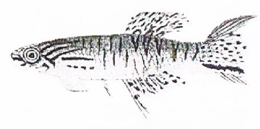

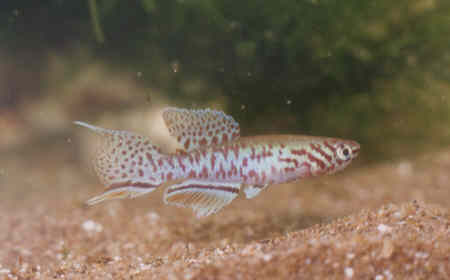
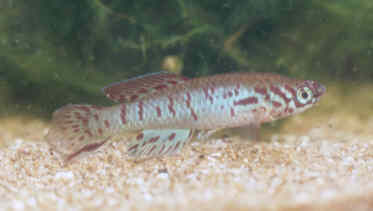
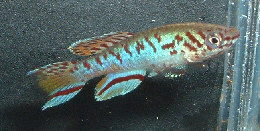


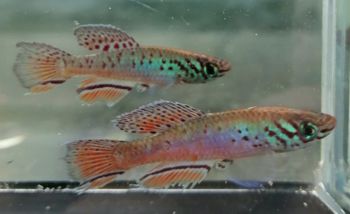

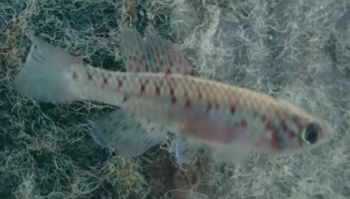
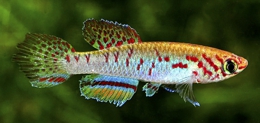

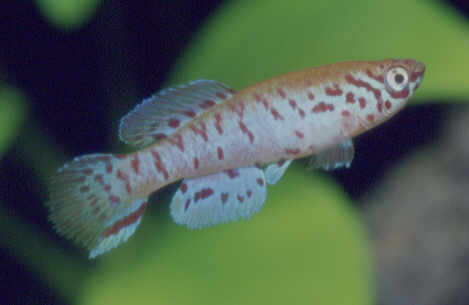
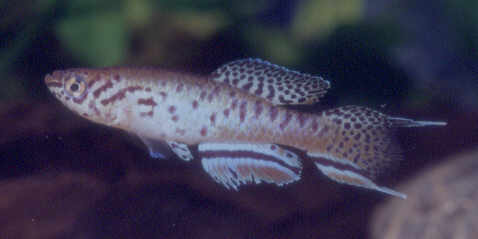
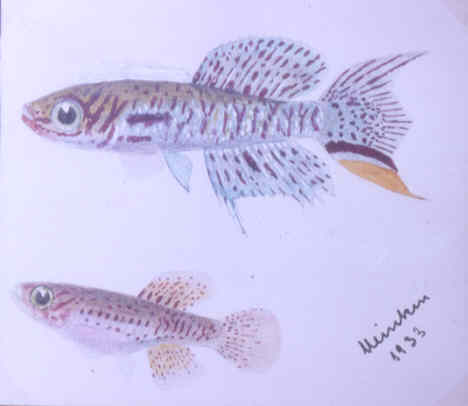
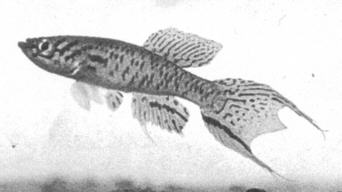
.jpg)